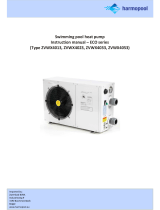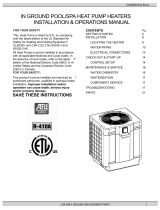
9
Setting the Temperature Controls - Pool or Spa
1. Turn the selected pool or spa thermostat dial clockwise to its highest setting.
2. The heat pump will start and begin to warm the pool or spa.
NOTE: The heat pump utilizes a short-cycle time delay device. If heat pump does not
start, wait five (5) minutes; the time delay may be preventing the heat pump from starting.
3. Initially, the typical spa may take several hours to heat, while a pool may take several days. Heating
time will depend on the volume of water, beginning water temperature, and the weather conditions at
the time of start-up. (Also see Table of Contents item: Calculating Initial Heating Time.)
4.When the pool or spa reaches the desired temperature, slowly rotate the thermostat knob
counterclockwise until the heat pump (just) stops. The thermostat is now positioned to automatically
maintain the set temperature.
HEATING-QUICK START & STOP
Switching Controls from Pool to Spa
NOTE: It is best to stop the water pump while repositioning valves.
1. Open spa valves and close pool valves.
2. With the spa water circulation pump operating for at least five minutes, move the POOL/OFF/SPA
toggle switch from the POOL setting to the SPA setting.
3. Turn the Spa thermostat fully clockwise (104º F). Heat pump should start (also see time delay note,
above).
4. Initially, the typical spa may take several hours to heat. Heating time will depend on the volume of
water, beginning water temperature, and the weather conditions at the time of start-up.
5. When the spa reaches the desired temperature (104º F is maximum), slowly rotate the SPA
thermostat knob counterclockwise until the heat pump (just) stops. The spa thermostat is now
positioned to automatically maintain the set temperature.
Start Up
1. With water pump OFF, position water valves to heat the POOL or SPA.
2. Set water pump controls to allow for temporary, continuous operation.
3. Rotate both thermostats counterclockwise to lowest temperature settings.
4. Depending on valve settings (per #1, above), position the POOL/OFF/SPA toggle switch to point at
either the POOL or SPA thermostat knob. Set HEAT/COOL toggle switch to HEAT position.
5. Ensure power is supplied to the heater, then start the water pump; the POWER and FLOW lights
should now both be lit. Permit the water pump to operate for five (5) minutes before proceeding.
To Stop the Heat Pump
The heat pump can be stopped by interrupting the electrical power supply, or by setting the desired temperature
lower than the actual water temperature. However, please note, if electrical power and water flow are present
to the heat pump, and the water temperature falls below 60ºF (with thermostat set to minimum), the heat pump
will operate to maintain the water temperature at 60ºF.
Time Clock Programming
Once the heat pump has brought the pool or spa up to temperature, it will be necessary to reset the
pump run-time controls. Be sure to allow enough running time for the heat pump to replace lost heat.
Required run time will vary depending upon the time of year. Colder months require longer running
times–generally eight to twelve hours/day.
This brief information is provided as an aide to installers, service personnel, and owners. The intent of this
section is to provide rapid access to (only) very basic operational information. Individuals who will be
routinely using, installing, maintaining, and servicing this heat pump, are strongly encouraged to read this
entire manual. If uncertain about any instructions given herein, AquaCal Customer Support (800-786-7751)
should be contacted for additional information. Note: The terms “Heat Pump” and “Heater” are used
synonymously.

























